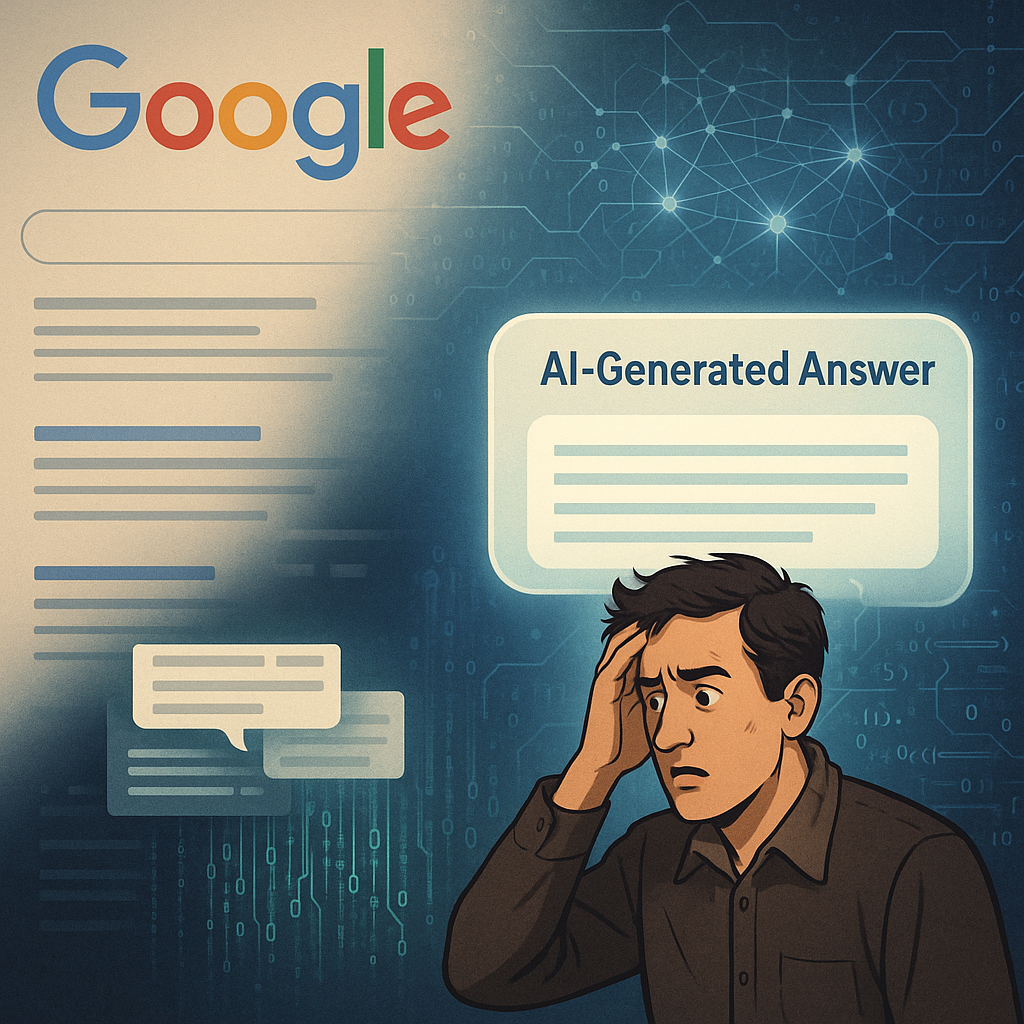How to Optimize Your Content for Google’s AI-Generated Search Results
SEO as we know it is undergoing a transformation. With Google increasingly using AI to generate answers directly in search results, traditional SEO...
%20(23).png?width=302&height=302&name=_SD%20web%20assets%202025%20(500%20x%20500%20px)%20(23).png)
4 min read
Marketing
:
Apr 24, 2025 12:42:29 PM
When Google introduced AI Overviews—its innovative machine-generated summaries that are seamlessly integrated into the top of search results—it presented them as beneficial enhancements designed to make information more readily accessible to users.
These overviews are intended to streamline the search experience by providing concise, relevant information directly on the search page, potentially saving users time and effort. While they may indeed fulfill this promise of accessibility, offering quick answers to user queries, they also seem to have an unintended consequence: significantly reducing the amount of traffic directed to the original content sources.
This shift in user behavior suggests that while AI Overviews enhance the user experience by delivering immediate information, they simultaneously divert clicks away from the websites that traditionally benefited from high search rankings.
 A recent study examining 300,000 keywords has shown that when an AI Overview is present, the clickthrough rate (CTR) for the top-ranking page decreases by 34.5% compared to similar searches without this feature.
A recent study examining 300,000 keywords has shown that when an AI Overview is present, the clickthrough rate (CTR) for the top-ranking page decreases by 34.5% compared to similar searches without this feature.
This represents a significant change, altering the traditional understanding of how ranking correlates with user engagement. At SmithDigital, we emphasize that the Search Engine Results Page (SERP) is a dynamic platform that continuously adapts to connect users with information.
With the introduction of AI Overviews, this landscape has shifted once more. Let's explore the implications of this development and the strategies marketing and sales leaders can employ in response.
For more than ten years, achieving the first position in Google search results was a reliable indicator of receiving significant user clicks. Although featured snippets and advertisements occasionally disrupted this expectation, it generally remained true.
However, AI Overviews have altered this dynamic. These overviews, which function similarly to enhanced featured snippets, aim to answer users' questions directly within the search results page by summarizing key information and citing sources. This often occurs without significantly increasing traffic to the original sources.
Since these overviews compile information from multiple pages, even if your content is cited, it may be one of many, reducing the likelihood of substantial clickthrough rates. This change is not an error in the system; it is an intentional redesign.
In the coming 12 to 24 months, marketers should prepare for substantial transformations in the digital environment. It is expected that AI Overviews will be more widely implemented across different types of queries and industries, potentially expanding their reach beyond informational search engine results pages (SERPs) to include transactional and commercial searches.
As users become more familiar with interfaces that provide direct answers, there is likely to be an increase in zero-click behavior, where more questions are answered directly on the SERP. This change is further complicated by the lack of transparency, as Google has not yet introduced separate tracking for AI Overview clicks in Search Console, making attribution challenging.
Furthermore, new monetization strategies are anticipated, with Google experimenting with ad formats within or around AI Overviews, which could further affect organic visibility. It is crucial for marketers to understand this as a critical juncture that necessitates a strategic evolution, rather than dismissing it as a temporary trend.
This period calls for an evolution in SEO practices rather than abandoning them. At SmithDigital, we are guiding clients to adapt to this changing landscape by redefining the concept of visibility and revising the strategies that achieve it.
From Rank to Real Reach
It's no longer enough to aim for a #1 ranking and expect results. The presence of AI Overviews means even top-ranked content can be buried beneath machine-generated summaries. Instead of fixating on position alone, brands need to measure influence within the SERP. Are you being cited by AI? Do you appear in image packs, related questions, or video modules? These placements increasingly determine whether users see—and click on—your content.
Optimize for AI Inclusion
To earn that visibility, content needs to be structured for AI interpretation. That means using clear question-and-answer formats, succinct definitions, and schema markup to help Google’s language models parse and summarize effectively. In today’s search environment, the goal isn’t just to rank. It’s to be referenceable.
Reinforce the Middle of the Funnel
As top-of-funnel clicks become less reliable, the smart move is to strengthen mid-funnel and conversion-focused content. That includes product comparison guides, ROI calculators, industry-specific case studies, and interactive demo assets. These are harder for AI to replicate—and more likely to convert.
Expand Beyond Organic Search
SEO is still a foundational channel, but it’s no longer the only pipeline worth building. Leading brands are increasing their investment in email nurture sequences, high-intent LinkedIn campaigns, content syndication, and AI-native platforms like ChatGPT, Perplexity, and Grok. These represent the next frontier of discoverability.
Leverage Buyer Intent Data
Where visibility fades, intent intelligence fills the gap. Tools like ZoomInfo, 6sense, and Bombora allow marketers to spot buying signals before a user ever clicks. These platforms help sales and marketing teams proactively engage high-intent accounts, even if they never fill out a form.
Use Reverse IP to Reclaim Lost Insight
Zero-click doesn’t have to mean zero insight. Reverse IP lookup tools let you identify anonymous traffic, resolve it to firmographic data, and deploy BDR teams more strategically. This allows you to pursue hot leads with personalized outreach the moment they engage—even if they never leave a trace in your CRM.
Establish Entity Authority
AI Overviews tend to favor clear, authoritative entities. That makes your brand’s digital footprint more important than ever. Ensure consistency across public databases like Wikipedia and Crunchbase, professional networks like LinkedIn, and structured website data via schema.org. Today, authority isn’t just earned through backlinks—it’s built through semantic clarity.
Marketers and sales leaders face a new kind of SERP—one where even top-performing content can go unseen. But this isn’t the end of search. It’s a new era, one where visibility comes from being the source AI trusts and cites, not just the site users click.
At SmithDigital, we’re helping B2B brands move from SEO to AI Discoverability Optimization—ensuring they’re not just ranking, but appearing in the answers that matter.
If you're seeing organic traffic dip or wondering how to stay competitive in this AI-driven SERP, let’s talk. We’re already helping clients adjust, adapt, and outperform.
-1.png)
SEO as we know it is undergoing a transformation. With Google increasingly using AI to generate answers directly in search results, traditional SEO...

Once, we searched. Now, we are told.

Can Deep Pages Enhance Your Google Visibility? 5 Key Insights from AI Overview Research Search engines are evolving. Recent findings from the...